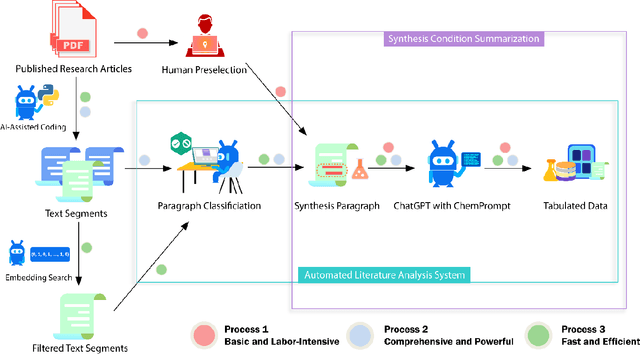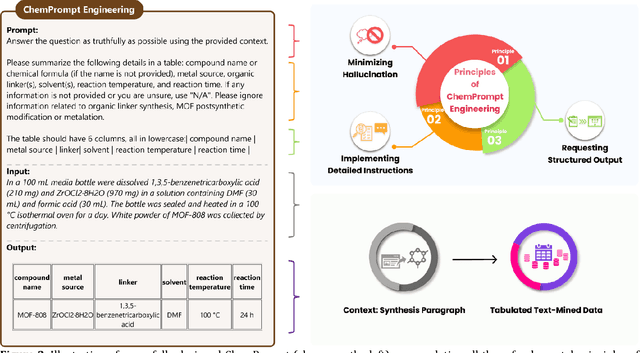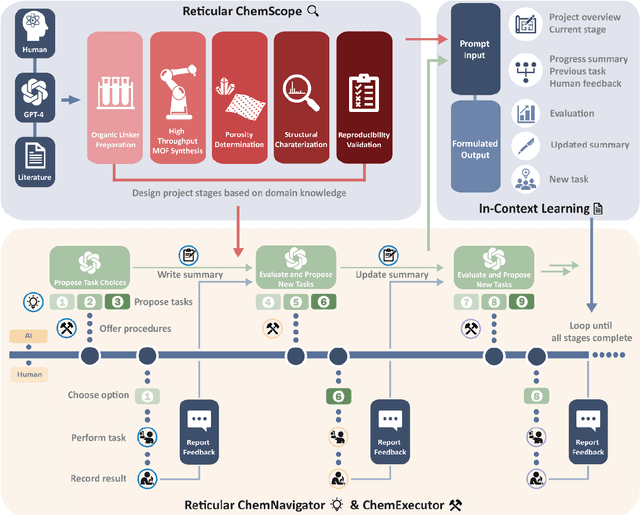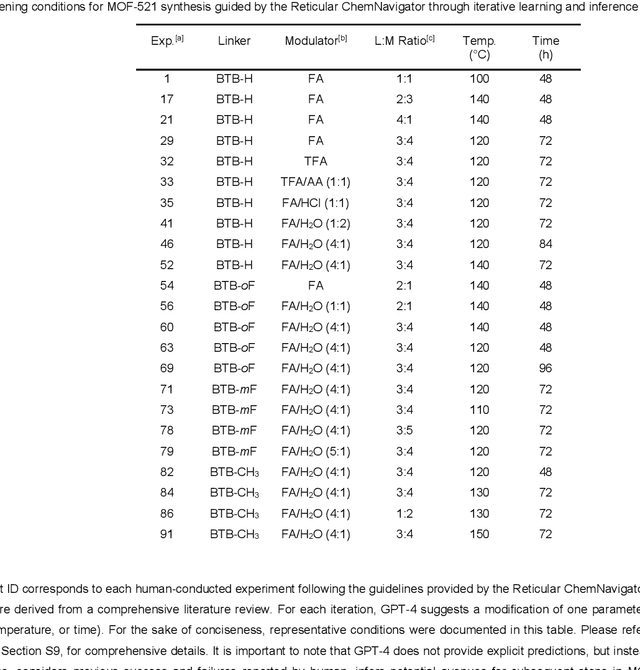Zhiling Zheng
System of Agentic AI for the Discovery of Metal-Organic Frameworks
Apr 18, 2025Abstract:Generative models and machine learning promise accelerated material discovery in MOFs for CO2 capture and water harvesting but face significant challenges navigating vast chemical spaces while ensuring synthetizability. Here, we present MOFGen, a system of Agentic AI comprising interconnected agents: a large language model that proposes novel MOF compositions, a diffusion model that generates crystal structures, quantum mechanical agents that optimize and filter candidates, and synthetic-feasibility agents guided by expert rules and machine learning. Trained on all experimentally reported MOFs and computational databases, MOFGen generated hundreds of thousands of novel MOF structures and synthesizable organic linkers. Our methodology was validated through high-throughput experiments and the successful synthesis of five "AI-dreamt" MOFs, representing a major step toward automated synthesizable material discovery.
Image and Data Mining in Reticular Chemistry Using GPT-4V
Dec 09, 2023Abstract:The integration of artificial intelligence into scientific research has reached a new pinnacle with GPT-4V, a large language model featuring enhanced vision capabilities, accessible through ChatGPT or an API. This study demonstrates the remarkable ability of GPT-4V to navigate and obtain complex data for metal-organic frameworks, especially from graphical sources. Our approach involved an automated process of converting 346 scholarly articles into 6240 images, which represents a benchmark dataset in this task, followed by deploying GPT-4V to categorize and analyze these images using natural language prompts. This methodology enabled GPT-4V to accurately identify and interpret key plots integral to MOF characterization, such as nitrogen isotherms, PXRD patterns, and TGA curves, among others, with accuracy and recall above 93%. The model's proficiency in extracting critical information from these plots not only underscores its capability in data mining but also highlights its potential in aiding the creation of comprehensive digital databases for reticular chemistry. In addition, the extracted nitrogen isotherm data from the selected literature allowed for a comparison between theoretical and experimental porosity values for over 200 compounds, highlighting certain discrepancies and underscoring the importance of integrating computational and experimental data. This work highlights the potential of AI in accelerating scientific discovery and innovation, bridging the gap between computational tools and experimental research, and paving the way for more efficient, inclusive, and comprehensive scientific inquiry.
ChatGPT Chemistry Assistant for Text Mining and Prediction of MOF Synthesis
Jun 20, 2023



Abstract:We use prompt engineering to guide ChatGPT in the automation of text mining of metal-organic frameworks (MOFs) synthesis conditions from diverse formats and styles of the scientific literature. This effectively mitigates ChatGPT's tendency to hallucinate information -- an issue that previously made the use of Large Language Models (LLMs) in scientific fields challenging. Our approach involves the development of a workflow implementing three different processes for text mining, programmed by ChatGPT itself. All of them enable parsing, searching, filtering, classification, summarization, and data unification with different tradeoffs between labor, speed, and accuracy. We deploy this system to extract 26,257 distinct synthesis parameters pertaining to approximately 800 MOFs sourced from peer-reviewed research articles. This process incorporates our ChemPrompt Engineering strategy to instruct ChatGPT in text mining, resulting in impressive precision, recall, and F1 scores of 90-99%. Furthermore, with the dataset built by text mining, we constructed a machine-learning model with over 86% accuracy in predicting MOF experimental crystallization outcomes and preliminarily identifying important factors in MOF crystallization. We also developed a reliable data-grounded MOF chatbot to answer questions on chemical reactions and synthesis procedures. Given that the process of using ChatGPT reliably mines and tabulates diverse MOF synthesis information in a unified format, while using only narrative language requiring no coding expertise, we anticipate that our ChatGPT Chemistry Assistant will be very useful across various other chemistry sub-disciplines.
GPT-4 Reticular Chemist for MOF Discovery
Jun 20, 2023



Abstract:We present a new framework integrating the AI model GPT-4 into the iterative process of reticular chemistry experimentation, leveraging a cooperative workflow of interaction between AI and a human apprentice. This GPT-4 Reticular Chemist is an integrated system composed of three phases. Each of these utilizes GPT-4 in various capacities, wherein GPT-4 provides detailed instructions for chemical experimentation and the apprentice provides feedback on the experimental outcomes, including both success and failures, for the in-text learning of AI in the next iteration. This iterative human-AI interaction enabled GPT-4 to learn from the outcomes, much like an experienced chemist, by a prompt-learning strategy. Importantly, the system is based on natural language for both development and operation, eliminating the need for coding skills, and thus, make it accessible to all chemists. Our GPT-4 Reticular Chemist demonstrated the discovery of an isoreticular series of metal-organic frameworks (MOFs), each of which was made using distinct synthesis strategies and optimal conditions. This workflow presents a potential for broader applications in scientific research by harnessing the capability of large language models like GPT-4 to enhance the feasibility and efficiency of research activities.
Symmetry-Informed Geometric Representation for Molecules, Proteins, and Crystalline Materials
Jun 15, 2023Abstract:Artificial intelligence for scientific discovery has recently generated significant interest within the machine learning and scientific communities, particularly in the domains of chemistry, biology, and material discovery. For these scientific problems, molecules serve as the fundamental building blocks, and machine learning has emerged as a highly effective and powerful tool for modeling their geometric structures. Nevertheless, due to the rapidly evolving process of the field and the knowledge gap between science (e.g., physics, chemistry, & biology) and machine learning communities, a benchmarking study on geometrical representation for such data has not been conducted. To address such an issue, in this paper, we first provide a unified view of the current symmetry-informed geometric methods, classifying them into three main categories: invariance, equivariance with spherical frame basis, and equivariance with vector frame basis. Then we propose a platform, coined Geom3D, which enables benchmarking the effectiveness of geometric strategies. Geom3D contains 16 advanced symmetry-informed geometric representation models and 14 geometric pretraining methods over 46 diverse datasets, including small molecules, proteins, and crystalline materials. We hope that Geom3D can, on the one hand, eliminate barriers for machine learning researchers interested in exploring scientific problems; and, on the other hand, provide valuable guidance for researchers in computational chemistry, structural biology, and materials science, aiding in the informed selection of representation techniques for specific applications.
 Add to Chrome
Add to Chrome Add to Firefox
Add to Firefox Add to Edge
Add to Edge